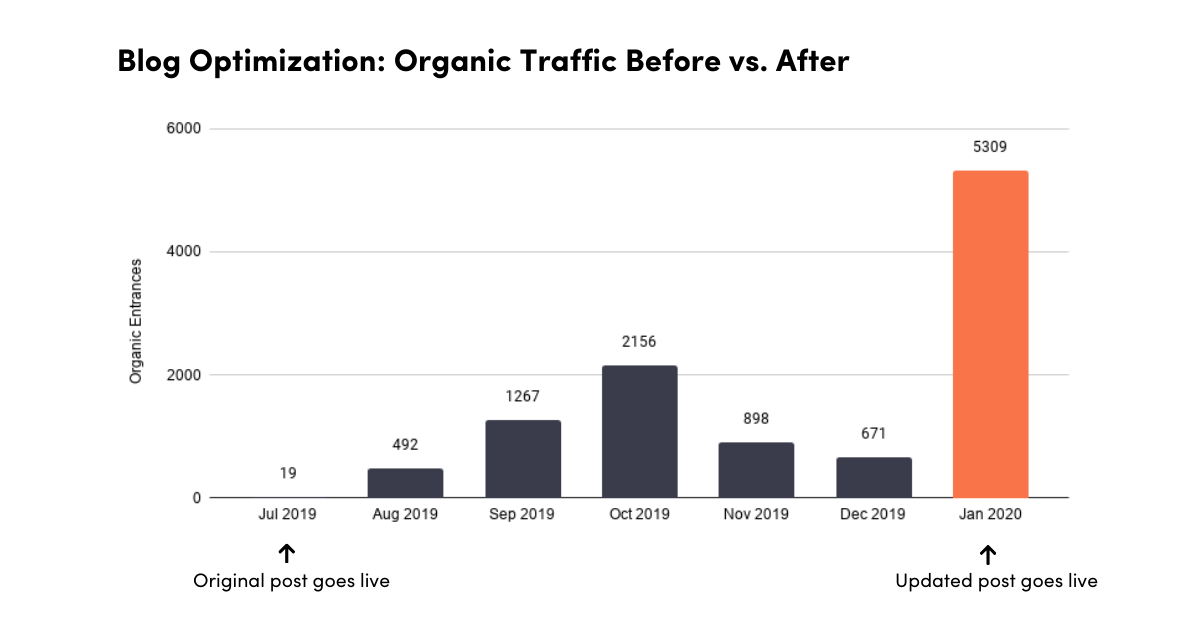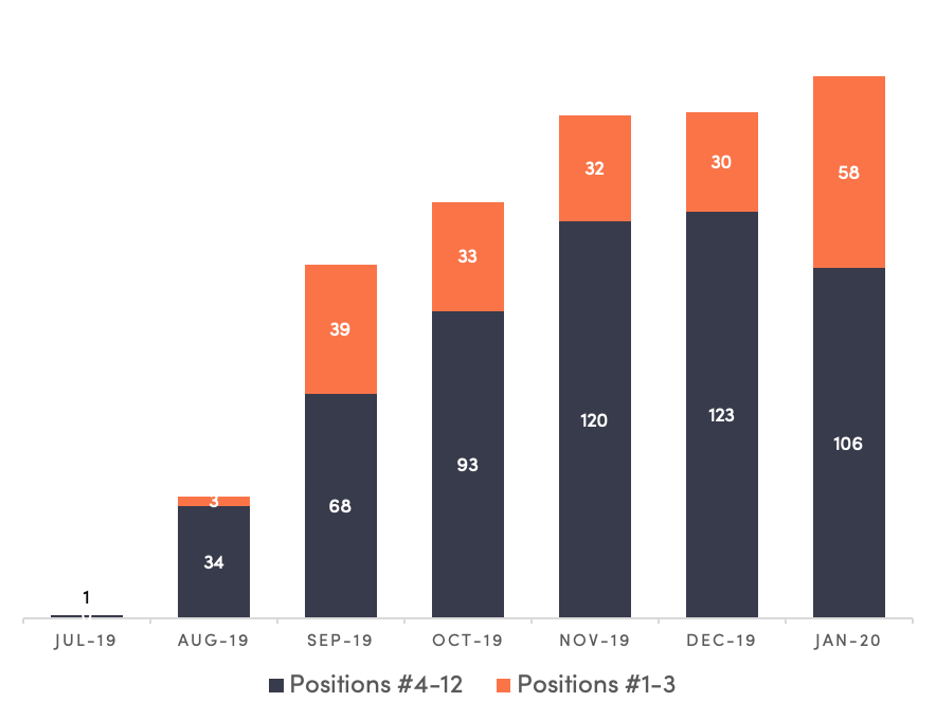
How to Boost SEO by Updating Old Blog Posts
July 15, 2022
One of the best ways to increase search rankings and boost organic traffic is to routinely update your old blog posts. If you don’t already have a system for doing this, no worries—we’ll get you there by the end of this post!
But first, let’s talk about why it’s so important to always be updating your blog content. I can think of six reasons of off the top of my head:
- It can improve search engine rankings and organic traffic for the blog that’s being updated, especially if the target keywords are “queries that deserve freshness” (QDF), essentially what Google thinks users are searching for now.
- Search engines generally like it when you update content on your site.
- Search engine algorithm updates are happening all the time, and they can disrupt your hard-won rank gains overnight.
- You can get more marketing mileage out of old content by re-promoting updated blogs on social media, email and other channels.
- It’s typically easier to update an old blog versus write a brand-new one.
- It’s a service to your readers to update old content with new information (and for financial companies, it can ensure your content is compliance-friendly).
Need proof? Here’s a recent case study from our own adventures in blog updating.
Case Study: One quick blog update; 478% increase in average monthly organic traffic
Last July, we identified a personal finance keyword opportunity for our client, an online lender. We wrote a blog optimized for the primary keyword and its associated secondary keywords, then pressed publish.
Three months after the blog went live, it was ranking on Page 1 for 126 target keywords. However, after its organic traffic peaked at 2,156 in October, we noticed entrances starting to decline. Our analysis revealed a few things that may have contributed.
- After a brief stint ranking between positions #1-3 for the primary keyword (which averaged 6,700 searches per month), the blog had dropped to position #5 for that keyword. We needed to get it back to the top of the page to continue driving more traffic.
- Similarly, the blog had dropped to Page 2 for several secondary target keywords, so we likely weren’t seeing any traffic from those keywords.
- There was an unconfirmed Google algorithm update in November that impacted Your Money or Your Life content (a reference for Google’s human search evaluators). Algo updates can happen unexpectedly at any time—and can tank your hard-earned rankings in a hot second, if you’re not paying attention.
Within six months of publishing, we decided to make a few updates to boost the post’s SEO results. Our step-by-step approach is outlined below, but here are a few specific things we did to improve our chances with this blog:
- We analyzed the search engine results page (SERP) for the primary keyword and found that almost all of the results were lists (as was ours)—but that most of the lists were longer than our post. Solution: We updated our list with a few more items to become the longest list on the SERP.
- We noticed that the post was getting impressions for target keywords with the word “free” in them, but the post did not currently use the word “free” in its title tag or meta description. Solution: We updated the title tag, meta description and body copy to incorporate the word “free” and improve click-through rate for those search impressions.
- We identified new opportunities for internal links from high-authority blogs and landing pages on the site. Solution: We added several internal links to the blog post using the primary keyword as anchor text.
Between the analysis and copy updates, we spent just a few hours optimizing this blog—faster than it typically takes to research and write a brand-new SEO-optimized blog post.
And the results? Within the first month of optimizing, the post drove almost as many organic entrances as it had in the prior six months it was live on the blog—a 478% increase in average monthly organic traffic.
Organic Traffic Before vs. After Update

It also saw a boost in keyword rankings, going from 153 page 1 rankings pre-update to 164 post-update. More importantly, we ranked in the top 3 positions for 58 keywords (vs. 30 the month before)—including our primary target keyword.
Ranking Distributions Before vs. After Update

Not bad for just a few hours of work. And in 3-6 months, we’ll update the post again so that we can continue to see better results.
OK, now for the fun part . . .
How to Update Old Blog Posts for an SEO Boost
Here’s our step-by-step process for updating old blog posts:
Step #1: Put it on the calendar.
Start by auditing your content regularly. This is something we do for our clients on a monthly basis, but you can do it quarterly if that’s easier to manage.
There are a few reasons for scheduling time to audit and update old blogs. First, if you do it sporadically, you run the risk of forgetting, and you’re not going to get the full benefits of this strategy.
Second, SEO stuff is changing all the time—from search engine algorithm updates to new content competing for your target keywords. Carving out time to make updates is the best way to ensure your content stays ahead of the curve.
Step #2: Start with high priority content.
The first time you audit your blog content, make a list of all the posts you consider high priority from an SEO perspective. Add new high priority posts to the list as they go live.
Here are a few opportunities to look for as you review each post:
- The facts related in the blog post have changed, and your readers would benefit from new information. (Is there recent news that would impact the topic of the post? If we re-shared this post today with new info, would it be helpful or interesting to our audience?)
- The blog post has declined in keyword rankings or organic search traffic. (Has there been an algorithm update? Are there new competitors dominating the SERP? Can we improve time-on-page with some visuals, or drive a few new inbound links?)
- The blog is ranking for its primary/secondary keywords but the click-through rate (CTR) is low. (Can we increase CTR through an updated title tag and meta description?)
Step #3: Look for other low-hanging fruit.
As you review your blog metrics, you may uncover non-high priority content that could be working harder for your site with just a few updates. For example:
- Posts that have high search impressions but low clicks (opportunity to update title tag/meta description for better CTR)
- Posts that are not ranking for their original target keywords but are within striking distance of Page 1 for a different set of keywords (opportunity to re-optimize the post for the new target keywords)
- Posts that have low dwell-time (opportunity to add visuals or more relevant content to give searchers what they need)
Step #4: Optimize.
You’ve probably guessed by now that we don’t recommend you update every single blog post each month. Keep it to your highest priority and best opportunity posts.
How you optimize each post will depend on the reason you’re optimizing it—here are a few examples:
- The facts related in the blog post have changed and the topic is still of interest to your readers. Solution: Update the post with the new information.
- The blog post has declined in keyword rankings because there is new competition in the SERP. Solution: Look at the competing pages to see how they are better, e.g., a longer list, more backlinks, longer copy, more compelling title tags, etc.
- The blog post has declined in organic search traffic. Solution: Determine whether keyword rankings or CTRs have declined, and adjust accordingly.
- The blog is ranking for desired keywords but the click-through rate (CTR) is low. Solution: Update title tag and meta description to highlight those keywords.
- The blog post is not ranking for target keywords but is close to ranking for other desired keywords. Solution: Re-optimize post for new target keywords.
And of course, it helps to make sure you’re optimizing posts the right way in the first place. Check out our SEO-optimization guide and template for blogs for easy-to-follow instructions.
Step #5: Re-publish and re-share
Make sure to update the date on the refreshed post, and then share it on social media, email and any other channels you typically use to promote new blogs.
This can also be a great opportunity to reach out to relevant influencers to let them know you’ve added new info to a post they might be interested in (only do this if it’s truly helpful for them—they don’t need to know about title tag updates).
Updating old blog posts: It’s all about the metrics
As you can see, the key to updating old blog posts for an SEO boost is to have a process in place, and a big part of that process is having easy access to blog metrics. You can’t identify update opportunities or see the benefits of this strategy if you’re not measuring results.
We provide SEO analytics and maintenance as a monthly service to our financial brand clients, but you can do it on your own using free tools like Google Analytics and Google Search Console. We also use Ahrefs, a paid tool, to track keywords rankings, backlinks and other SEO-specific metrics.